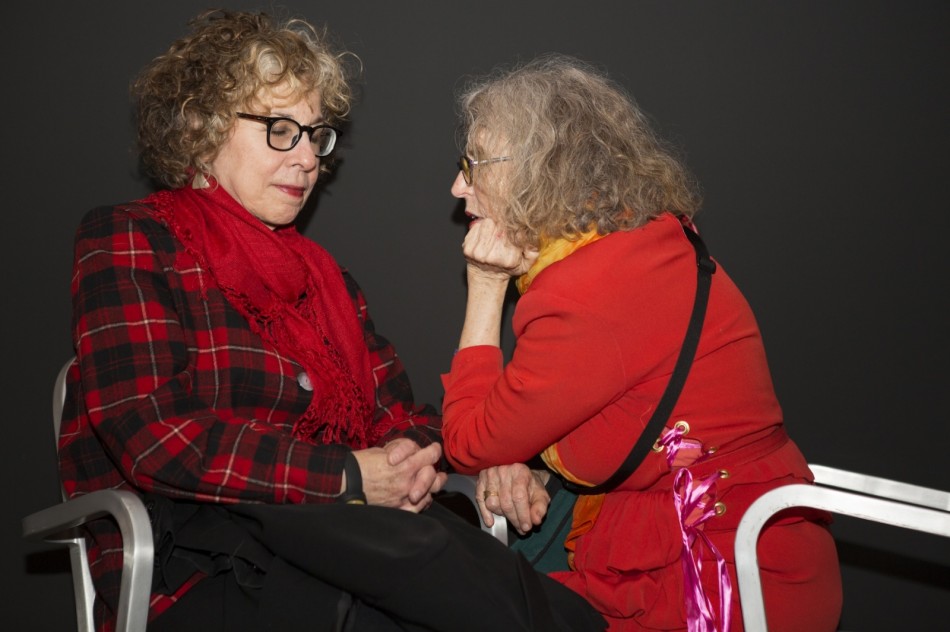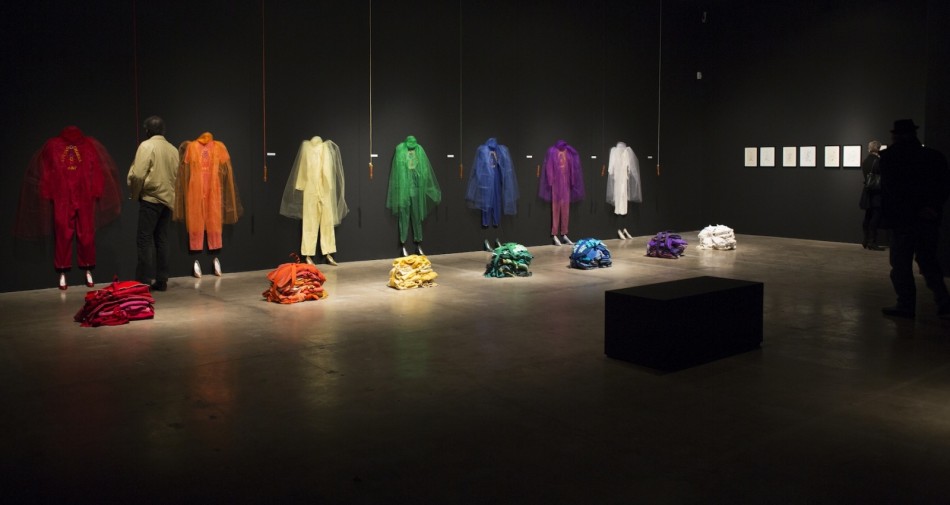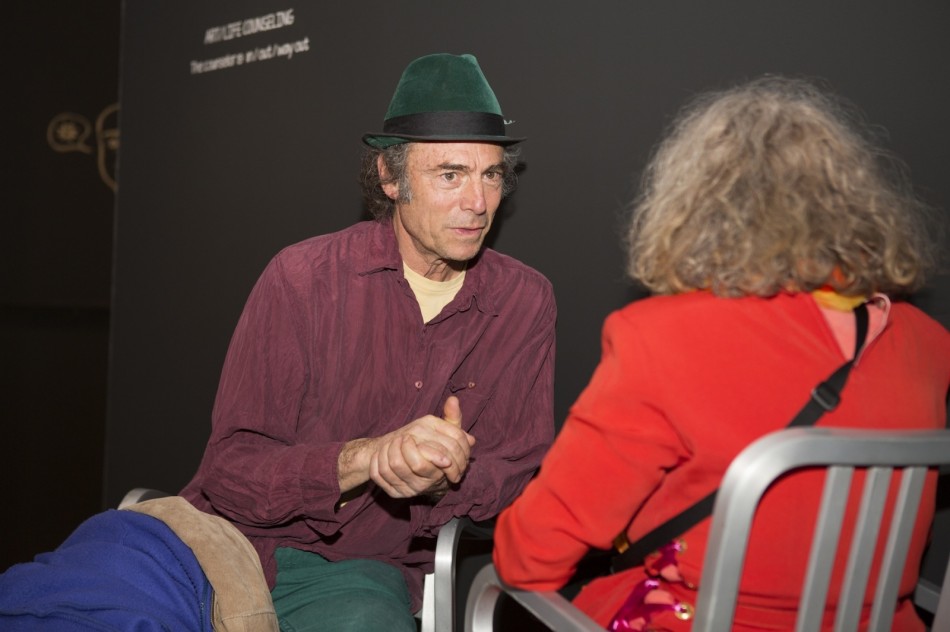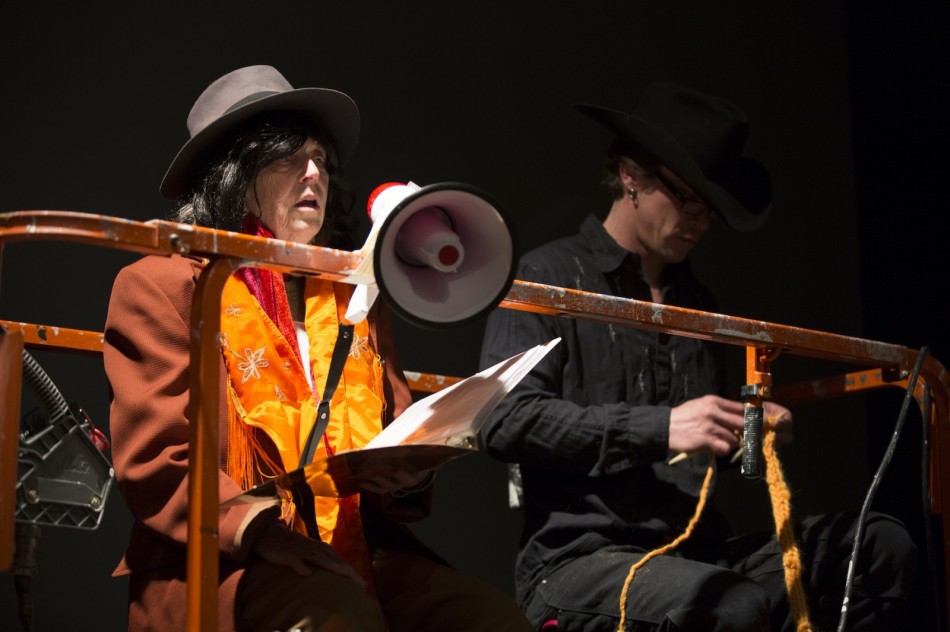
“Endurance” Counseling, “Durational” Art
SITE Santa Fe presented Always Creative, a retrospective of Linda Mary Montano’s 40-year career. Montano, who lives and works in Saugerties, NY, is best known for Rope Piece, her collaboration with Taiwanese performance artist Tehching Hsieh—in which the artists were tied together by an eight-foot section of rope for one full year from July 4, 1983, to July 3, 1984. (All photos,installation views of Linda Mary Montano’s Always Creative:©Kate Russell, courtesy SITE Santa Fe.)
Montano began creating “durational” performance art in the 1960s.
What is “durational” performance art? “Durational” performance art applies to a performance event that endures over an extended period of time; time becomes a significant part of the artists’ content. This mode is enjoying a vivid revival in the international art world.
Once the genre of a small group of performance artists such as Christopher Burden and Marina Abramovic, endurance performance has become the fascination of celebrities. Last March, actress Tilda Swinton began napping in a glass box at MOMA. Then in July, rapper Jay-Z brought the art and music worlds together for his six hour “Picasso Baby” performance, where he repeatedly sang his track “Picasso Baby” with a cast of New York artists, critics and celebrities.
Montano was a pioneer in the form, but spent years at the fringes of critical attention and isn’t alone. Today, as many younger artists explore the impact of creating ephemeral performance experiences in the commodified and market-driven art world, Montano’s abiding performance career and spiritual resolve seems all the more real. I interviewed her by telephone.

Rubinstein: How did the idea of “Art/Life Counseling” originate?
Montano: I grew up a very, very strict Catholic and I remember with great fear and trembling going into a confessional box, booth, room– where there were two black curtains and then a door and a priest sitting in the middle . . . So that was the beginning . . . I took the model from Catholic confession.
What I was taking was that authority to be in charge, the boss, the one who knows, the therapist, the forgiver, the priest, because in Catholicism that was relegated to men only.
Rubinstein: You’ve been performing this situation for a long time. Tell me about “Art/Life Counseling’s” evolution?
Montano: I did a piece at The New Museum, the 14 Years of Living Art (1984-1998), and for seven of those years I relegated a rule that said I would go once a month (there) and do Art/Life counseling, which at that time was composed of tarot, palm and psychic readings.
Marcia Tucker was, at that time, the director of the museum and she gave me a room for seven years and for every year it was painted the color that I was wearing. In fact, the work was Naropa Institute -inspired because they had these colored rooms at Naropa I had read about. So much of that piece really does have a Naropa connection in that the color of the room would influence me. So that is the story of Art/Life Counseling; is the back-story.
 Rubinstein: Bring us up to date.
Rubinstein: Bring us up to date.
Montano: The current story is that around 10 to 15 years ago, I came back to the church when I started teaching full time at The University of Texas, Austin. I had students for seven years, and I had never been a mother, so I didn’t know about accountability and consequence. When I became a full-time teacher, I thought, ‘Oh my God…these kids, these young adults are beginning to do what I do.’ And, ‘Oh my God, I don’t know what to do.’
I started talking about responsibility to children. I mean they were not children, they were young adults, but they were dealing with very heavy-duty psychological issues as performance. I wanted them to be safe and also creative. So I changed my format. Whenever I did Art/ Life Counseling from then on, I started doing the feminist/Catholic version, which is right now what I do: prayer– and I ask people to think about what is going on with them–and together, democratically, we come up with some sort of conjecture that has nothing to do with the occult or me as an authority over them.
I am really, really, trying to see more clearly.
I do Art/Life Counseling as endurance also. I do a seven-hour version of it. By that time, I am just there. It is body-to-body, person-to-person, hand-to-hand, and flesh-to-flesh. It’s just two people doing FaceTime without their computers, without their iPods, iPhones and e-mails.
 Rubinstein: What are your thoughts about the recent trends in museum performance art exhibitions? Do you consider yourself still a part of the larger performance world?
Rubinstein: What are your thoughts about the recent trends in museum performance art exhibitions? Do you consider yourself still a part of the larger performance world?
Montano: I am connected and I am not connected. I am lucky because I don’t have to be.
I am 71 and I am looking for a site to do a sculpture show because I started in sculpture; I want to do a retrospective of my sculpture and installations.
SITE did a beautiful job of presenting things and they are redoing my book as a workbook. It is called “You, Too, Are A Performance Artist.” It’s a recipe book, basically. It’s more of a teacher’s book: Here’s what Linda did, and here’s how you can do it, kind of book.
Again, that concept of legacy and children: showing these children in college how they can be one [an artist/ performer] too. Although they don’t need that because they have the Internet, they have Google, they have YouTubes, they have Twitter, they have Vimeos. The younger generation–they have Dancing With The Stars. They are already performance artists. I mean you turn on T.V., any schlocky program, and there are forty thousand people acting like performance artists.
We were neurotic, we were psychotic, we were bipolar, and poor, but we wanted to change our consciousness. The current young people are Shakti-potted and endured, and tri-atheleted, and they have no qualms what so ever about money and Kickstarting and grants. And they are healthy. (Laughs.) . . . And we were saying, ‘We are doing our thing, we are poor and we are sick, but we are spiritual.’
Rubinstein: As a younger person in the middle of that, having been in an academic, M.F.A environment, they are not healthy. The same issues are there.
Montano: Specifically, I am talking about money. Money and fame, we didn’t want that. We didn’t want either of those things. We wanted to be spiritual and we wanted to be cured, enlightened–and we would still be poor and un-famous.

